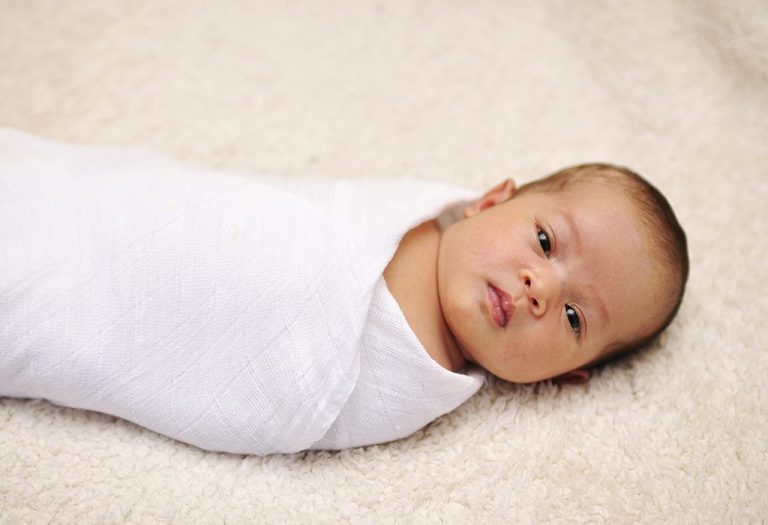How to Swaddle a Baby?

Swaddling is recognised as a highly beneficial action for the baby. However, there are times when it might be harmful if it is not done using the proper technique. Newborns and swaddling have a long and intertwined history, with swaddling providing a sense of security and warmth that mimics the confined environment of the womb. This can help soothe fussy babies, improve sleep quality, and reduce the startle reflex that often wakes them up. It’s crucial to remember that every baby is unique, and their individual needs and preferences will vary. Some babies may enjoy being swaddled for longer periods, while others may show signs of discomfort early on.
Read on to learn how to swaddle your baby appropriately.
What Is Swaddling?
Swaddling is a technique of pacifying a baby by wrapping him in a blanket to ensure that he is warm, cosy and comfortable. A baby can be swaddled in two ways – one method is tighter, more protective, while the other is done in a loosened-fashion, leaving the arms free. Swaddling can be done even after the baby is a month old, especially when he sleeps, to minimise any impact on his mobility.
Why Swaddle Your Baby?
The benefits of swaddling a newborn are numerous, making it a popular choice for many parents. Here are some of the key benefits of swaddling:
- Swaddling is done to improve the baby’s sleep by soothing him.
- Initially, it might be difficult, and the baby might even get frustrated, but eventually, this process enhances calm, peaceful and better sleep.
- It improves the neuro-muscular development of the baby.
- It reduces the risk of Sudden Infant Death Syndrome (SIDS) and its effects by keeping the babies on their backs while sleeping.
- It helps infants get uninterrupted sleep for a prolonged period.
- It helps recreate the womb space and comforts the baby with familiar surroundings during his first month.
When to Swaddle Your Newborn
When to swaddle is a choice parents can make. Some do it any time of the day, whenever the baby gets fussy, while others follow it only during the night, habituating the baby to sleep quickly when he is wrapped.
How to Swaddle a Baby
There are many techniques followed for swaddling a baby, but the most common procedure is explained below:
- To swaddle, place the blanket out horizontally, with a few inches the top edge folded down.
- Place the baby facing-upwards on the blanket, with his head above the folded edge.
- Align the baby’s left arm, wrap the left side of the blanket over his body, and tuck it under his right side, leaving his right arm out.
- Then put the baby’s right arm down and wrap the right side of the blanket over his body. Tuck it nicely under the left side.
- Fold or twist the blanket’s bottom loosely by pleating it under one side of the baby. Make sure that the baby’s hips can move and that the blanket is not too tight.
This is the most common way of swaddling, where we put the baby on his back and gently drape the blanket like a diamond by tucking the edges diagonally, and making sure both the legs are free and out of the blanket.
Other swaddling techniques include square swaddle and sleep sack swaddle. The square swaddle is a technique wherein a baby is placed on a blanket that resembles a square before beginning the process. The sleep sack swaddle is a product that has an adjustable swaddle wrap which is designed to prevent the startle reflex in babies.
Choosing a technique is all about the comfort level of your baby. These swaddling techniques are suitable for newborn babies who are not used to sleeping well and require to be held all the time.
How Long Should You Swaddle a Newborn?
It’s generally recommended to stop swaddling your baby once they show signs of trying to roll over, which usually happens around 2 months of age. If you’re unsure when to stop swaddling, consult with your pediatrician. They can assess your baby’s development and provide personalized guidance.
Disadvantages of Swaddling a Baby
A baby swaddle is a double-edged sword as it has equal benefits and drawbacks depending on the kind of technique followed.
The process of swaddling may interfere in the bonding and attachment between babies and parents. A few common physical problems have also been noticed. The major physical challenges your baby might experience due to incorrect swaddling are:
1. Overheating
Overheating is one risk that can occur if the baby is not swaddled properly. The baby may not be able to move freely inside, and this can cause a rise in body temperature.
2. Hip Dysplasia
Hip dysplasia is a medical condition wherein the growth and development of the hips are hindered due to being locked up in an immovable state. Whenever a baby moves his legs, the femur bone movement inside the socket supports the changes happening to the joints. Otherwise, the socket will develop into a plate-like structure leading to shallow sockets that cause problems with hip movement. This might affect the functioning of the joints in the long run.
3. Respiratory Tract Problems
When a baby is tightly swaddled, it restricts his ability to breathe, which could lead to Sudden Infant Death Syndrome (SIDS). The correct way to swaddle a baby should be followed, or else the likelihood of upper respiratory tract infections increases.
4. Restricted Movement
Swaddling can significantly limit a baby’s ability to move their arms and legs. This restricted movement can hinder their motor development and prevent them from exploring their bodies and the world around them.
When to Stop or Avoid Swaddling a Baby
When to stop swaddling is one of the major concerns that all mothers have. Swaddling is a technique which may limit the movement of limbs. Limb movement is essential for the development of the muscular and central nervous system. As per the American Academy of Pediatrics (AAP), you should consider stopping swaddling when your baby looks like he is trying to roll over. Many babies learn to do this between 4-6 months.
Can You Swaddle a Newborn at Night?
A common question regarding swaddling is – can you swaddle a baby at night? Yes. Swaddling can be done at night, but the right procedures must be followed to ensure the baby gets good sleep. If you follow the right techniques and precautions, you can swaddle for 4-5 months.
Precautions to Take While Swaddling
There are a few precautions that can be followed if you want to swaddle your baby. These include:
- It is not recommended to allow a swaddled baby to sleep on his stomach as it might increase the risk of SIDS. The baby must be lying on his back, on a comfortable, and safe surface, when swaddled to avoid suffocation and breathlessness.
- The health of the baby in combination with his respiratory rate plays a crucial role in deciding the extent to which the parents can swaddle him. Ensure that the baby is taken for regular check-ups before going ahead with the swaddling.
- The material used for swaddling can be used as an aid in minimising the related after-effects of swaddling. Generally, lighter and soft blankets are used for wrapping babies to avoid any physical discomfort.
- It is not advised to swaddle babies very tightly. Sometimes, parents do this to prevent the baby from freeing up and getting hurt. Holding on to the baby tightly, on the other hand, would obstruct breathing and cause dislocation along with dysplasia.
- A movement monitor can help monitor the baby’s movements when swaddled for longer durations and help parents lookout for warning signs. If these little precautions are followed, parents don’t need to worry about how long to swaddle their babies.
FAQs
1. Can I swaddle my premature baby?
Swaddling premature babies requires extra caution and should only be done under the guidance of a neonatologist. Premature babies often have difficulty regulating their body temperature and may be at increased risk of overheating.
2. Can I use a sock to keep my baby’s hands from startling them during swaddling?
No, using a sock to restrain your baby’s hands during swaddling is not recommended. It can restrict their movement and increase the risk of overheating.
3. Can I use a bath towel to swaddle my baby after a bath?
While a towel can provide warmth after a bath, it’s not an appropriate substitute for a swaddle blanket. Towels can be too thick and may increase the risk of overheating.
Swaddling helps parents put their infant children to sleep. During their first month in the outside world, infants need all the rest they can get. Though there are some inherent dangers, using the right techniques on swaddling will ensure that the baby will be safe and sound.
References/Resources:
1. Swaddling: Is it Safe for Your Baby?; American Academy of Pediatrics; https://www.healthychildren.org/English/ages-stages/baby/diapers-clothing/Pages/Swaddling-Is-it-Safe.aspx
2. Swaddling your baby; Pregnancy, Birth & Baby; https://www.pregnancybirthbaby.org.au/swaddling-your-baby
3. Swaddling Your Baby; Nemours Kids Health; https://kidshealth.org/en/parents/swaddling.html
4. How to Keep Your Sleeping Baby Safe: AAP Policy Explained; American Academy of Pediatrics; https://www.healthychildren.org/English/ages-stages/baby/sleep/Pages/A-Parents-Guide-to-Safe-Sleep.aspx
5. Hip-Healthy Swaddling; International Hip Dysplasia Institute; https://hipdysplasia.org/infant-child/hip-healthy-swaddling/
6. McDonnell. E, Moon. R; Infant Deaths and Injuries Associated with Wearable Blankets, Swaddle Wraps, and Swaddling (The Journal of Pediatrics); National Library of Medicine; https://pmc.ncbi.nlm.nih.gov/articles/PMC3992172/; May 2015
7. Crying baby: What to do when your newborn cries; Mayo Clinic; https://www.mayoclinic.org/healthy-lifestyle/infant-and-toddler-health/in-depth/healthy-baby/art-20043859
Also Read:
Tips and Tricks to Swaddle Baby in Summer
When and How to Stop Swaddling a Baby
What Is a Swaddle Bath and How to Give One?
Was This Article Helpful?
Parenting is a huge responsibility, for you as a caregiver, but also for us as a parenting content platform. We understand that and take our responsibility of creating credible content seriously. FirstCry Parenting articles are written and published only after extensive research using factually sound references to deliver quality content that is accurate, validated by experts, and completely reliable. To understand how we go about creating content that is credible, read our editorial policy here.

























